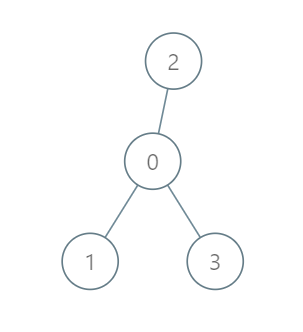2477. Minimum Fuel Cost to Report to the Capital
Description
There is a tree (i.e., a connected, undirected graph with no cycles) structure country network consisting of n cities numbered from 0 to n - 1 and exactly n - 1 roads. The capital city is city 0. You are given a 2D integer array roads where roads[i] = [ai, bi] denotes that there exists a bidirectional road connecting cities ai and bi.
There is a meeting for the representatives of each city. The meeting is in the capital city.
There is a car in each city. You are given an integer seats that indicates the number of seats in each car.
A representative can use the car in their city to travel or change the car and ride with another representative. The cost of traveling between two cities is one liter of fuel.
Return the minimum number of liters of fuel to reach the capital city.
Example 1:
Input: roads = [[0,1],[0,2],[0,3]], seats = 5 Output: 3 Explanation: - Representative1 goes directly to the capital with 1 liter of fuel. - Representative2 goes directly to the capital with 1 liter of fuel. - Representative3 goes directly to the capital with 1 liter of fuel. It costs 3 liters of fuel at minimum. It can be proven that 3 is the minimum number of liters of fuel needed.
Example 2:
Input: roads = [[3,1],[3,2],[1,0],[0,4],[0,5],[4,6]], seats = 2 Output: 7 Explanation: - Representative2 goes directly to city 3 with 1 liter of fuel. - Representative2 and representative3 go together to city 1 with 1 liter of fuel. - Representative2 and representative3 go together to the capital with 1 liter of fuel. - Representative1 goes directly to the capital with 1 liter of fuel. - Representative5 goes directly to the capital with 1 liter of fuel. - Representative6 goes directly to city 4 with 1 liter of fuel. - Representative4 and representative6 go together to the capital with 1 liter of fuel. It costs 7 liters of fuel at minimum. It can be proven that 7 is the minimum number of liters of fuel needed.
Example 3:
Input: roads = [], seats = 1 Output: 0 Explanation: No representatives need to travel to the capital city.
Constraints:
1 <= n <= 105roads.length == n - 1roads[i].length == 20 <= ai, bi < nai != biroadsrepresents a valid tree.1 <= seats <= 105
Solutions
Solution 1: Greedy + DFS
According to the problem description, we can find that all cars will only drive towards the capital (node \(0\)).
Suppose there is a node \(a\), its next node is \(b\), and node \(a\) needs to pass through node \(b\) to reach the capital. In order to make the vehicles (fuel consumption) of node \(a\) as small as possible, we should greedily let the vehicles of the child nodes of node \(a\) converge to node \(a\) first, and then distribute the vehicles according to the number of seats \(seats\). The minimum number of vehicles (fuel consumption) needed to reach node \(b\) is \(\lceil \frac{sz}{seats} \rceil\). Where \(sz\) represents the number of nodes in the subtree with node \(a\) as the root.
We start a depth-first search from node \(0\), using a variable \(sz\) to count the number of nodes in the subtree with the current node as the root. Initially, \(sz = 1\), representing the current node itself. Then we traverse all the child nodes of the current node. For each child node \(b\), we recursively calculate the number of nodes \(t\) in the subtree with \(b\) as the root, and add \(t\) to \(sz\), and then we add \(\lceil \frac{t}{seats} \rceil\) to the answer. Finally, return \(sz\).
The time complexity is \(O(n)\), and the space complexity is \(O(n)\). Here, \(n\) is the number of nodes.
1 2 3 4 5 6 7 8 9 10 11 12 13 14 15 16 17 18 19 | |
1 2 3 4 5 6 7 8 9 10 11 12 13 14 15 16 17 18 19 20 21 22 23 24 25 26 27 28 29 30 31 | |
1 2 3 4 5 6 7 8 9 10 11 12 13 14 15 16 17 18 19 20 21 22 23 24 25 26 | |
1 2 3 4 5 6 7 8 9 10 11 12 13 14 15 16 17 18 19 20 21 22 23 | |
1 2 3 4 5 6 7 8 9 10 11 12 13 14 15 16 17 18 19 20 21 22 | |
1 2 3 4 5 6 7 8 9 10 11 12 13 14 15 16 17 18 19 20 21 22 23 24 25 26 | |





